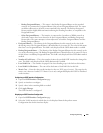
Configuring Routing 477
•
Advertise Secondaries
— Select
Enable
or
Disable
from the drop-down menu to indicate the
advertiseability of all secondary addresses. By default all the secondary addresses would be advertised
on an interface enabled for OSPF.
•
Router Priority
— Enter the OSPF priority for the selected interface. The priority of an interface is
specified as an integer from 0 to 255. The default is 1, which is the highest router priority. A value of 0
indicates that the router is not eligible to become the designated router on this network.
•
Retransmit Interval
— Enter the OSPF retransmit interval for the specified interface. This is the
number of seconds between link-state advertisements for adjacencies belonging to this router
interface. This value is also used when retransmitting database descriptions and link-state request
packets. Valid values range from 0 to 3600 seconds (1 hour). The default is 5 seconds.
•
Hello Interval
— Enter the OSPF hello interval for the specified interface in seconds. This parameter
must be the same for all routers attached to a network. Valid values range from 1 to 65,535. The default
is 10 seconds.
•
Dead Interval
— Enter the OSPF dead interval for the specified interface in seconds. This specifies
how long a router waits to see a neighbor router's Hello packets before declaring that the router is
down. This parameter must be the same for all routers attached to a network. This value should a
multiple of the Hello Interval (for example 4). Valid values range from 1 to 65535. The default is 40.
•
LSA Ack Interval
— The number of seconds between LSA Acknowledgment packet transmissions,
which must be less than the Retransmit Interval.
•
Interface Delay Interval
— Enter the OSPF Transit Delay for the specified interface. This specifies
the estimated number of seconds it takes to transmit a link state update packet over the selected
interface. Valid values range from 1 to 3600 seconds (1 hour). The default value is 1 second.
•
MTU Ignore
— Disables OSPF MTU mismatch detection on receiving packets. The default value is
Disable.
•
Passive Mode
— Enable this mode to make the interface passive to prevent OSPF from forming an
adjacency on an interface. OSPF advertises networks attached to passive interfaces as stub networks.
Interfaces are not passive by default. It is common to configure an OSPF interface to be passive when
OSPF must advertise the subnets configured on the interface, but routers on the subnet belong to
other OSPF domains, such as an OSPFv3 router at the end of a 6to4 tunnel.
•
Network Type
— Sets the OSPF network type on the interface to broadcast or point-to-point.
–
Broadcast
—
OSPF only selects a designated router and originates network LSAs for broadcast
networks.
The default network type for Ethernet interfaces is broadcast.
–
Point-to-Point
— When there are only two routers on the network, OSPF can operate more
efficiently by treating the network as a point-to-point network. For point-to-point networks, OSPF
does not elect a designated router or generate a network link state advertisement (LSA). Both
endpoints of the link must be configured to operate in point-to-point mode.


















